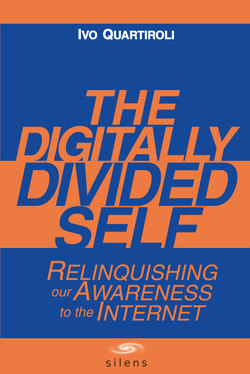Читать книгу The Digitally Divided Self: Relinquishing our Awareness to the Internet - Ivo Ph.D. Quartiroli - Страница 26
На сайте Литреса книга снята с продажи.
Our Identity With Tools – from Chimps to Chips
ОглавлениеApart from humans, only a few animals have the physical characteristics and mental capacities for using tools, monkeys foremost among them. Hand movements are controlled by the F5 area of the brain. Giacomo Rizzolatti (Umiltà, 2008) of the University of Parma recorded the cerebral activity of two macaques after they had learned to grasp food with pliers. He documented the activity in the F5 area and in F1, which is involved in the manipulation of objects. He discovered the same cerebral activity whether the monkeys grasped food by hand or with the pliers. The neuronal activity, he concluded, is transferred from the hands to the tool, as if the tool were the hand and its extremity the fingers.
Furthermore, Rizzolatti pointed out that the F5 area is rich in mirror neurons, a type that he had previously discovered, which become excited both when an act is being performed and when another individual is observed performing that act. The discoveries, according to Dietrich Stout, an archeologist specializing in the use of tools, tell us that “obviously, the use of instruments by the monkeys implies an incorporation of the instruments in the body scheme, literally it is an extension of a body” (Umiltà, 2008).
A monkey cannot distinguish between its own hands and the tool it uses, as if the tool were an actual extension of its body. This brings to mind what Marshall McLuhan said about the media and tools as extensions of our bodies and minds, be it a tool for hunting or the "technology" of language, the printing press or our contemporary cognitive extensions.
Tools may be like body extensions on a neural level even for humans, but our discriminating awareness allows the understanding that the tool is something “out there.” In Rizzolatti’s experiment, the factor of consciousness, still elusive to neuroscience, is missing. Neither the presence nor absence of consciousness nor what it is about can be identified by experiments.
The monkey does not experience the duality produced by human self-consciousness, so it may seem closer to a spiritual condition of “union with everything” – beyond dualities. However, this union occurs on a pre-conscious level, not as the culmination of a conscious path toward truth.
Our consciousness of ourself is at the same time both joy and distress, since it entraps us in the dual mind, separating us from the rest of existence, and splitting our psyche into conflicting parts. But it also allows us to achieve intellectual tasks unknown to our hungry macaque. Self-consciousness, and consequently the development of an ego which separates us from existence, is the intermediate phase between the monkey’s mind and a spiritually enlightened state.
Like the monkey, every time we use tools, we can lose the awareness of ourself. Even knowing that we are separated from the instrument, our attention tends to be drawn toward the tool, and we forget ourself. The monkey cannot recognize what is other than himself. Maybe humans have the same attitude when dealing with tools – our old friends – with which we merged since ancient times, thus stimulating the evolution of our nervous system and, thereby, assuring our survival.
This forgetting of ourself happens more easily with tools which act on the mind, like TV or the Internet, which absorb us till we give attention exclusively to external stimuli. This is reminiscent of the attention we once needed to give our environment in order to survive.
Much of the appeal of technology rests on its capacity to arouse a sense of urgency and wonder in us. Magic tricks are effective when our awareness becomes redirected or highjacked by the magician. Electronic gadgets are like magic boxes – decreasing our awareness of their broader meaning and directing our attention to its seductive glimmer, creating a totalitainment society.
When we are involved with any gadget, it is difficult to remain an observer, to be in touch with ourself instead of disappearing into the tool and the flow of information.
